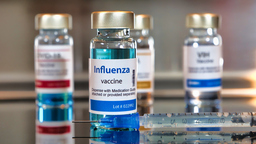Combined Agonist Adjuvants for Vaccines
TECHNOLOGY NUMBER: 2021-322

OVERVIEW
A combined adjuvant approach that improves influenza vaccine efficacy- An application that mimics the pattern of innate activation during natural infection
- A favorable safety profile with options for intranasal or parenteral administration
BACKGROUND
Current influenza vaccines are limited by low immunogenicity, short duration of protection, and narrow cross-strain efficacy. These vaccines only influence the immune system to create antibodies that are specific to one strain of influenza and therefore fail to induce a more robust cellular immunity. An effective vaccine needs to stimulate a broad-based cellular immune response as well as mucosal immunity. Retinoic acid-inducible gene I (RIG-I)-like receptors (RLRs) are key sensors of virus infection, mediating the transcriptional induction of type I interferons and other genes that collectively establish an antiviral host response. Both viral and host derived RNAs can trigger RLR activation and cause an effective antiviral response, though this response can cause immunopathology if RLR activities are uncontrolled. A need exists for approaches that permit vaccines to induce a more broad-based yet controlled immune response.
INNOVATION
Researchers have developed a novel method for using two adjuvants which promote adaptive antibody and T-cell responses to various viruses. The additives include a nanoemulsion (NE) based adjuvant as well as an RNA-based RIG-I agonist. The oil-in-water NE and a synthetic RNA from the Sendai virus (IVT DI) can individually elicit protective immunity to influenza via distinct mechanisms, though the use of both can cause a broader and optimized immune response.Together, the combined NE/RNA adjuvant contains agonists for multiple key innate receptors, allowing it to target multiple key antiviral pathways and magnify their activation. The NE has an intrinsic ability to inactivate enveloped viruses while maintaining conformational antigen epitopes. It also is an antigen carrier which can facilitate cellular uptake and processing. IVT DI activates the RIG-I receptor and induces type-I interferon and TH1 immunity. The adjuvants produce a response that appears to be synergistic rather than additive. The NE/RNA can be formulated for use with both a recombinant protein and whole virus-based antigens, allowing for mucosal or parenteral routes of administration.